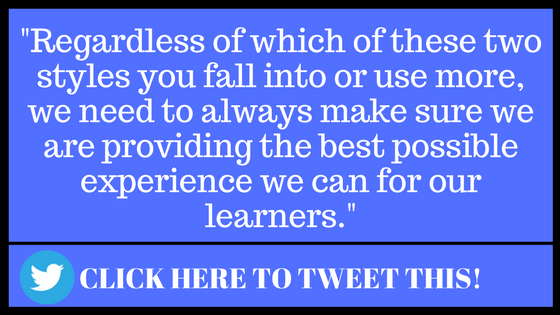Personalized learning and differentiated learning are big buzzwords in education right now.
Did you think they were the same thing?
As more catch phrases, tag lines, and buzzwords get added to the educational world, it’s getting more and more difficult to determine what it all means, and more importantly, how it all applies to our classrooms. Two phrases I’ve been hearing a lot lately and very often interchangeably are differentiated learning and personalized learning. While based on the same basic principals of providing students with what they need, there are some important differences that should be noted.
What They Focus On.
Personalized Learning starts with a single learner and connects with their interests, passions, and aspirations. The learner becomes an active participant in the design of their experience and have choices in how they will experience it. This focuses on the creation and development of independent learners who reflect, monitor and set goals.
Differentiated Learning starts with the needs of groups of learners and adjusts instruction, tasks, or activities to the needs of those groups. We as the teacher adapt and modify instruction based on the learner needs. This scenario requires learners to be dependent on the guidance of the teacher to support learning.
Personalized Learning allows the learner to select the technology and resources that are appropriate for them to support learning or demonstrate understanding. The focus once again is based on a student centered process and selection of instructional modifications or development to meet their interests or capacity.
Differentiated Learning demands that the we as the teacher select the needed resources for groups of learners in order to meet their needs. This is absolutely crucial to the success of some learners and it should be noted that when choosing technology that it supports already well-developed pedagogy and doesn’t replace it.
[Scroll down to keep reading!]Time Based vs. Competency-based
Personalized Learning fully supports a competency-based model of instruction and assessment. Assessment becomes part of the learning process and allows students to show mastery at their own pace in a more student centered model. The additional focus on student driven pace and experience is a great fit for competency-based learning because it demands that instruction and progress are based on mastery and understanding, not seat time.
Differentiated Learning can also support competency-based learning, but focuses more on teacher centered instruction and decisions that guide pacing and the timeline of instruction. This lends itself in general to a more seat time based model where we as the teacher are in control of moving the class forward or slowing down to meet the needs of small groups.
NOTE: I want to state that both of these models can absolutely be utilized to support competency-based models of instruction, but personalized learning absolutely supports its philosophy and components with more fidelity.
There isn’t a “Right” Answer.
Regardless of which of these two styles you fall into or use more, we need to always make sure we are providing the best possible experience we can for our learners. There are times when differentiating for a small group of students based on their need is absolutely the best instructional decision you can make. Other times, allowing students to be more independent and have more choice will help ignite, motivate, and inspire their learning in your classroom.
These things can be layered and utilized in conjunction with one another. The important thing is that we understand the difference.




